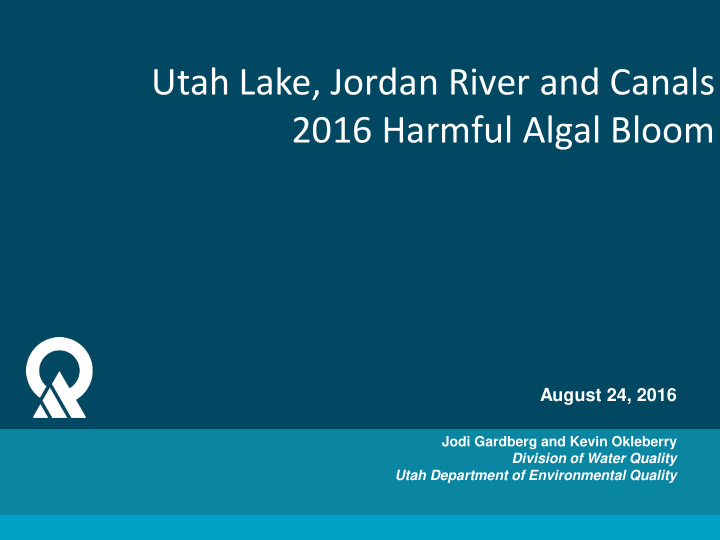



Utah Lake, Jordan River and Canals 2016 Harmful Algal Bloom August 24, 2016 Jodi Gardberg and Kevin Okleberry Division of Water Quality Utah Department of Environmental Quality
Cyanobacteria and their toxins (cyanotoxins) • Liver, nerve, or skin toxins • Selectively produced by many genera but not very predictable • Widely distributed but not often at acutely toxic levels • Analyses are available for some but not all of these toxins Nodularia Dolichospermum Cylindrospermopsis Aphanizomenon Microcystis - Nodularin (liver) -Cylindrospermopsins -Anatoxin-a (nerve) (Anabaena) -Microcystin (liver) - Found in brackish (liver) -Cylindrospermopsins -Toxin is most -Microcystins (liver) water including bays -Saxitoxins (nerve) (liver) common and easily -Anatoxin-a/a(s) of Great Salt Lake -Benthic/epiphytic rather -Saxitoxins (nerve) measured (nerve) than planktonic -160 congeners -Saxitoxins (nerve) Division of Water Quality
Types of Analysis • Species Identification and cyanobacteria cell count concentrations – Rushforth Phycology • 24 to 48 hour turn around time • Cyanotoxin pre-screening test strips – • Day of sampling • Limited to cylindrospermopsins, microcystins and anatoxin-a (not saxitoxins) • Cyanotoxin analysis – Greenwater Lab • 48 to 96 hour turn around time Division of Water Quality 3
UDEQ/UDOH Guidelines for HABs Toxin Producing Blue- Relative Probability of Acute Health Risks Action Recommended green algae Cell Health Risk Density (cells/mL) <20,000 Negligible None Very Low Issue caution advisory; Short-term effects e.g. Post CAUTION sign; 20,000-100,000 Low to Moderate skin irritation, gastrointestinal illness Weekly sampling recommended Issue warning advisory; 100,000 – 10,000,00 or As above for low risk, Post WARNING sign; Moderate to High reports of animal and potential for long- illnesses or death term illness Weekly sampling recommended >10,000,000 Issue Danger Advisory; or Post DANGER sign; large scum mat layer As above for moderate or Very High risk, and potential for Weekly sampling recommended acute poisoning reports of human illness; Consider Closure Division of Water Quality
Timeline July 13 July 14 July 15 July 16 July 17 July 18 July 19 • Jordan River • Bloom reported • Utah Lake closure • Aerial survey • Several • Utah County • DWQ collected samples >700,000 to DWQ issued by Utah showed algal municipalities Jordan River additional cells/mL County Health scum moving into shut down closure issued phytoplankton Aphanizomenon Department and Jordan River secondary water and toxin samples • Large algal mats Department of supply for analysis observed Health • Salt Lake County • Algae scums between Provo Health redeveloping in • Guidance issued Bay and Utah • Large visible mats Department posts public access for residential Lake State Park • UDAF advisory observed on July “Warning” signs locations irrigation issued 13 had been blown to • First samples southside shores • Utah Poison collected • Samples collected at public access Control reports locations, Utah illnesses related • Aphanizomenon Lake Outlet ,and to HAB exposure samples > Jordan Narrows 10,000,000 cells per mL were confirmed • Aerial survey Division of Water Quality 5
July 13, 2016 Sampling Division of Water Quality 6
July 2, 2016 July 11, 2016 Division of Water Quality 7
July 15, 2016 Division of Water Quality 8
Utah Lake Closure Division of Water Quality
What About the Jordan River? Division of Water Quality 10
Division of Water Quality 11
Utah Poison Control Center 636 Reported Cases (As of August 1) Human Exposure 81% Recreated in or exposed to (504) Utah Lake Water Animal Exposure 4% 14 dogs (8 UT Co., 5 SL Co., 1 (27) WY) Information only 14% (86) 31% of cases are symptomatic Symptoms Reported: GI: diarrhea, nausea, vomiting, and abdominal pain Skin: rash and irritation Neuro: headache, dizziness, drowsiness Ocular: irritation Division of Water Quality 12
HAB Monitoring Network • Utah Water Quality Board Funding - $100,000 • 3 Open water buoys • YSI sondes (dissolved oxygen, pH, temperature, specific conductivity, chlorophyll a, phycocyanin) • Telemetered real-time data linked to publicly available I-Utah network. • Water chemistry and phytoplankton sampling Division of Water Quality 13
How Does it Compare? July 11, 2016 October 18, 2014 Division of Water Quality 14
How does it compare? Division of Water Quality 15
HAB Decision-making Algorithm [Tier 1] Division of Water Quality
Multiplier effects of temperature & nutrients Decreased Increased water levels water (through temperature demand and precip changes) HABs Increased Increased internal growing nutrient season loading Increased external nutrient loading Division of Water Quality 17
Nutrient Sources • Publically owned treatment works (POTWs) (largest) • Stormwater • Agricultural runoff • Natural background Division of Water Quality 18
Population Growth 140 1,600,000 Utah Lake Watershed Wastewater 1,400,000 120 Treated Sewage Discharge (MGD) Population Utah Lake Watershed 1,200,000 100 Population Estimate 1,000,000 80 800,000 60 600,000 40 400,000 20 200,000 0 0 1980 1990 2000 2010 2030 2060 Utah Secondary TBPEL Standards Utah Lake Basin: 176% Growth Division of Water Quality
Nutrient Reduction Success: Deer Creek Reservoir Deer Creek Reservoir Algal Blooms (1970s) Deer Creek Reservoir Algal Blooms (1990s) Division of Water Quality 20
Other Utah HABS • Scofield Reservoir • Payson Lakes (Big East, McClellan and Box lakes) Division of Water Quality 21
QUESTIONS
Recommend
More recommend